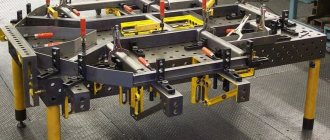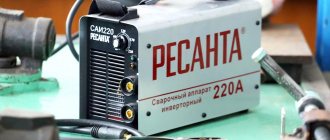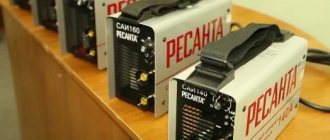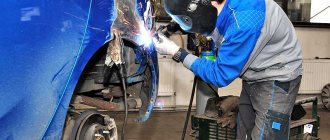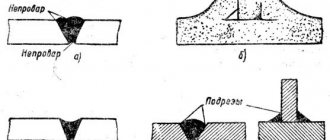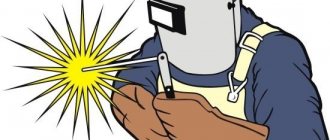The welding log is an important document in the work of professional builders. In this register, the employee keeps records of all welding work carried out at the site. Only a welder of the third category and higher has the right to conduct it. The order for its maintenance is issued by the manager and signed by the employee who is assigned to maintain it.
- Form and sample
- Online viewing
- Free download
- Safely
FILES
The obligation to keep a log of welding work must be specified in the employment contract or the employee’s job description. Labor legislation in this case makes it clear that inattention is unacceptable here. After all, the level of responsibility during all construction, in particular welding, work is colossal.
Welding log function
The main objective of the document is to control the implementation of complex technological processes associated with the manufacture of metal structures.
The journal helps you keep track of the following:
- compliance by employees with safety regulations and requirements for workplace organization;
- following the procedure for carrying out the welding work itself;
- compliance by employees with technological requirements for the speed of joint formation and the quality of the seam.
The welding log is considered a type of executive document.
Its presence at production or construction sites is mandatory.
Documentation is classified depending on its purpose:
- Logbook for monitoring and checking the quality of welding processes. Helps monitor the work of welders on drilling rigs, power plants, and other important facilities.
- Book of accounting of certain types of welding, for example, argon arc. Necessary to monitor compliance with the requirements for this type of work.
The document has full legal force. In case of investigation into the causes of emergency situations, papers are provided to the court.
We recommend that you read
You can also read an article about technological maps for welding work.
Entering test results
In everyday practice, control is carried out mainly visually. An external inspection of the seam by a professional allows you to see defects on the resulting surface, the dimensions of which exceed 0.1 mm. The presence of inclusions of oxidized alloys is noticeable.
A more thorough inspection using fluorescent color examination can detect capillaries emerging to the surface. Internal cavities of minimal size can be identified through radiation, magnetic, and acoustic tests. It is impossible to control welding work every time using these methods.
The analysis is carried out selectively, with a frequency determined by management and inspecting organizations. The results of control tests are drawn up in a form that complies with the standards. Inspection data is also recorded in a log.
Who is responsible for filling it out?
Each team of workers fills out a welding logbook separately. Even if there are several groups of employees at the site, each of them creates its own document.
After completing work on the site, employees hand over the log.
Marks are given by the following persons:
- welders;
- master responsible for welding;
- representative of the controlling organization.
Recommended reading: The difference between AC and DC welding
Maintaining documentation is regulated by legislative acts. Persons who refuse to fill out a welding log are subject to sanctions, including dismissal or a large fine.
Welding log appendix
In addition to the main pages of this regulatory document, it contains a special appendix for posting information about tolerances with a standard example of filling out welding journal formats.
For example, only employees over 18 years of age and having the following documents can be allowed to work with welding units:
- medical examination;
- records of technical mastery of the profession;
- records of completion of all mandatory types of training;
- passing examination tests with notes on grades and comments;
- description of practical training courses.
In addition to these specialized records, the application must contain all marks of completion of training and safety instructions and first aid courses.
Appendix to the welding log.
Additionally, the application should describe any factors affecting the welder during the work process.
Here's what a welder may be exposed to during the welding process:
- high risk of electric shock or arcing;
- burns of various locations and pathological effects of high temperatures;
- exposure of exposed skin to molten drops of metal and sparks;
- radiation effect;
- X-ray irradiation during the isotope welding method or welding of the isotopes themselves;
- negative effect of fields with different polarities in the electromagnetic field;
- damage to the respiratory tract due to inhalation of combustion products of oxides and electrodes;
- the effect of ionized air, harmful to the lungs;
- harm from loud noise;
- the effect of pronounced vibration;
- possible cuts from sharp edges and edges of welded workpieces.
Specific factors affecting the human body when working with synthetic materials and gas spraying are as follows:
- high-frequency electromagnetic fields with frequent and rapid pole changes;
- exposure to toxic substances released during combustion such as ethylene oxides, formaldehydes, acetone vapors, solvents, etc.
The format of the document can change; it is ordered from the printing house in accordance with the wishes of the customer - the enterprise. In addition, it must comply with generally accepted standards and technical regulations for industrial safety.
Businesses that neglect the rules and do not keep logs may be subject to serious penalties from government inspection bodies. If the disorder in the journal depends on a specific employee, he can be punished up to and including dismissal.
ZhSR form and sample
The document is a thin stack of forms, numbered, stitched and certified with the seal of the enterprise.
The accounting book forms vary, but the following sections are required:
- title page;
- sheet with data of engineering and technical personnel;
- a form with a list of welders working at the site;
- quality control tables for welded joints.
In addition to standard sections, the welding journal includes a large amount of clarifying data:
- names of project documents and enterprises that approved the papers;
- list of welded metal structures;
- description of types and markings of seams;
- operating parameters of gas or electric welding machines (prescribe brands of individual equipment components, types of consumables used);
- types of defects identified, methods used to eliminate deficiencies;
- notes on detected cases of violation of the technological map of welding works.
A sample of filling out the ZhSR, shown in the photo, will help you understand what the document should look like.
Internal content
The following pages of the magazine contain sequential lists in tables. The first list provides data on engineering and technical specialists with the obligatory indication of educational level, the exact name of the specialty, and position.
The dates for the start of activities at this facility, confirmation of qualifications, and completion of the welding task are also filled in here.
The following list of the journal contains information about specific welders, indicating last names and initials; level of professional qualifications; complete information about the certificate confirming the right to carry out welding work.
The line ends with a record of preliminary control and test welding of samples. Highly qualified workers who have the right to weld with a personal mark indicate its license plates.
According to the sample presented in the F-56 standard, then in the journal you need to fill out a table presenting the date, change, laconic characteristics of the part, alloy grade.
There are columns in which you need to indicate the designations on the drawing or the number of the element with which the welding work was carried out; the nature of the auxiliary materials used and complete weather data at the specified point in time, if the welding was carried out outdoors.
The journal ends with a table indicating information about the acceptance of the work. It contains conclusions, comments to welders, signatures indicating the performer and the employee authorized to control the production operation during welding work.
Sections and their completion
The log of work on welding metal and PE (polyethylene) structures consists of separate blocks.
Title pages
The initial page contains complete information about the production site and the enterprises operating on it.
A standard title page includes the following elements:
- name, legal form of the subcontractor organization;
- description of a construction or industrial facility;
- data of the employee responsible for maintaining housing and communal services;
- information about designers, types of technical documentation;
- registration code for installation or welding work;
- data from the manufacturer of the metal structures being welded, inspection acceptance mark;
- last name, first name, patronymic of the Gostekhnadzor representative;
- start and end dates of document maintenance.
The first page is completed by the person identified by the contractor. Welders enter only technical information about the work being carried out.
List of technical engineers
The list includes data from employees responsible for quality control of technological processes. The list may consist of several names, but most often only 1 engineer is indicated.
We recommend reading: How to weld hinges and awnings on gates yourself
The building regulations establish the requirements for such an employee. The project manager is the director of the construction company or the chief engineer.
Team of welders performing the work
This section includes the following data:
- General information. Full names, qualifications, numbers and validity periods of employee IDs are recorded.
- Permit data. A list of works that can be performed by certain welders is indicated. Processes can be standard, low-level, or high-altitude.
- A note on completed tests. The welder provides the samples he has made, and the inspector evaluates the quality of the seams made, indicating the score received.
- Welder's mark. Installed when performing critical work, for example, welding pipelines or tanks operated under high pressure. The number of the specialist’s personal mark is entered in the journal.
Main work table
The page is divided into 13 columns, when filling out which the following order is observed:
- The first column contains the date the work was completed and the work shift number. In the case of welding in the daytime, put the number 1, in the evening - 2, at night - 3.
- The second column contains markings and names of parts being welded. Each welder is responsible for the quality of the welds made.
- The third column describes the joints and the numbers of welded units. Marking is indicated according to the drawing of the object (block).
- The fourth column should contain the receiver's mark. After its installation, the construction stage is considered completed.
- The fifth column contains data on the electrodes used and filler wire. The brand and batch number of consumables are indicated.
- The sixth column (climatic conditions) in a simplified format contains only temperature. Sometimes the presence of precipitation, strong wind or frost is prescribed. The latter option is preferable, because when investigating the causes of an accident, the smallest details are important.
- The seventh column contains information about the welder.
- The next 3 columns contain the name, signature, and mark number of the master responsible for compliance with the technology.
- Columns 11-13 are led by the receiver. The specialist gives an assessment, signature, and, if necessary, indicates any comments.
We recommend reading: Welder salary
End of the magazine
The last page of the document indicates the total number of sheets. The data of the head of the enterprise that issued the journal is written down and his signature is affixed. The organization's seal is placed at the bottom of the page.
Completing of the work
The main table of the journal tells about what and to what extent of work was carried out, whose columns contain:
- Date of completion of work, shift.
- The name of the elements being connected, their steel grade.
- The location and number of the welding joint is determined from the drawing or diagram.
- A mark on delivery and acceptance of the welded assembly.
- What welding materials were used, their delivery batch number.
- Climatic conditions (usually only temperature is indicated, but it is also advisable to indicate wind speed and the presence of precipitation).
- Details of the welder, his license number.
- Brand number and personal signature of the employee.
- The signature of the person responsible for the work (site foreman, chief engineer, etc., this is a mandatory item in each column.).
- Has the welded joint been accepted? If yes, then it is given “satisfactory”.
- Notes or comments on the work performed.
At the very end of the magazine it is noted how many pages it contains. Firmware for a magazine involves connecting its individual pages with threads, numbering each one, and sealing this structure with a paper strip. There should also be a seal of the organization here. It should partially cover the spine of the magazine's firmware. The signature of the manager who must keep the document completes the picture.
Attention! The welding work log must be kept for at least 10 years from the date of preparation. And if employees worked in hazardous working conditions, then all 75. If desired, documentation of this kind is transferred to the archive.


